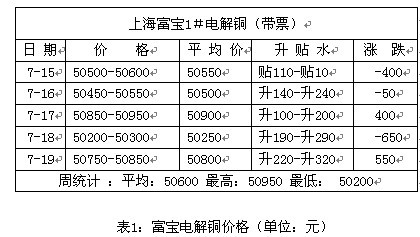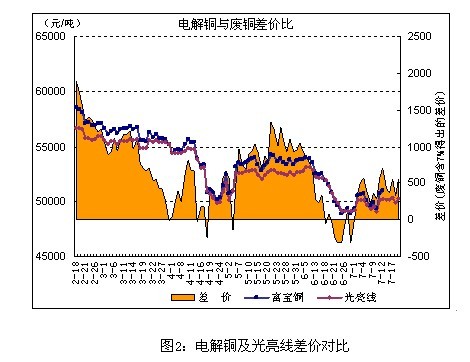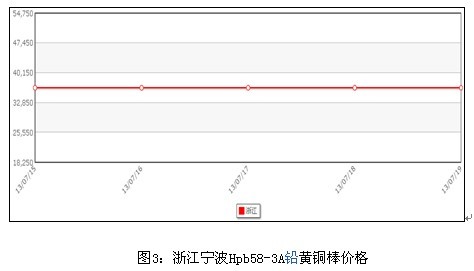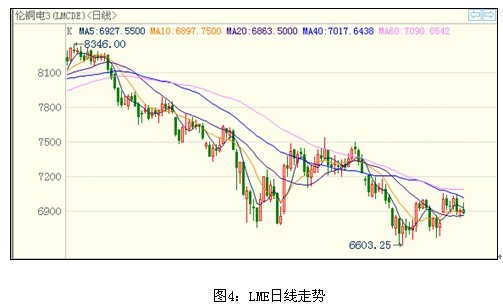Abstract Core Tips: Europe and China's weak economy and poor supply of copper demand are still the main considerations for market shorting, but the US's fear of exiting QE has eased, and the US dollar index is unlikely to show strong growth in the short-term, which is good for metal trends; Copper prices will continue to fluctuate widely next week...
Core Tips: Europe and China's weak economy and poor supply of copper demand are still the main considerations for short selling, but the US's fear of exiting QE has eased, and the US dollar index is unlikely to show a strong rise in the short-term, which is good for metal trends; The weekly copper price will continue the pattern of wide fluctuations. The downside support is 6750 USD, the upward pressure is 7000 USD; the corresponding Shanghai copper is 4.85-51,000; the spot copper is 4.9-5.1 million, and the scrap copper is 4.55-4.75 million. First, the electrolytic copper market
This week, the Shanghai copper futures did not change much. Although there were some downsides during the period, the gaps were replenished near the weekend, and the corresponding spot price was only between 50,000 and 51,000 yuan. The specific spot price data is as follows:

The most prominent feature of the spot market this week is that the good copper premium is unusually high, completely ignoring the copper rise and fall during the session, and has always maintained a strong upward trend. As of Friday afternoon, it has approached 400 yuan/ton of water. For the current high water, the small amount of copper is one of the reasons, the big households are the real behind-the-scenes push. Throughout the week, the traders are mainly responsible for moving goods. The downstream only buys weekends at low prices on Thursday, and the other periods are dominated by wait-and-see attitudes. Although the finished copper market appears to be hot, and according to the Fubao Copper Research Group, the scrap copper merchants have begun to sell out, but the downstream copper processing companies have not had new orders, the real demand has not yet opened, and the copper price is not easy to be short-lived. Active turnover boosted.

In the past week, the Yangshan copper premium continued to fluctuate around 180 US dollars. At the same time, the spot copper spot discount continued to widen, and the previous premium did not return, which also hinted at the weak copper demand in the euro zone. This week, the spot copper in the East China region is expected to be difficult to sustain next week. The Shanghai-Lennon ratio is likely to continue to rise. It is expected to be near 7.3.
Second, the recycled copper market
Electrolytic copper and bright lines
This week, the price of scrap copper fluctuated within a narrow range. Compared with last week, the overall increase did not fall. This week's highest average price is 47,050, the lowest is 46,650, which is in line with our judgment on the scrap copper market. Judging from the trend of copper prices, in the short term, external forces are not enough to break the current balance. We believe that we will maintain a wide-ranging shock pattern next week.

In June, the average operating rate of copper rod enterprises was 68.89%, of which the operating rate was 76.4%, the operating rate of medium-sized enterprises was 72.7%, and the operating rate of small enterprises was 58.8%. In the survey, some small and medium-sized enterprises added orders. Not as good as before, there has been a downward trend. The survey data is shown in the table below.
In terms of inventory, there are 26 total inventories, 22 in less than 1,000 tons, accounting for 52.4%; 4 in 1,000 tons or more, accounting for 10%; not in stock and not ready for storage in the later period. There are 16 companies, mainly due to the instability of copper prices and weak market demand.
Third, the downstream market analysis
This week, Zhejiang Jinlong Hpb58-3 brass rod ex-factory price has not changed, the price has remained at 36,500 yuan / ton. Comparing the copper price of the period, it can be seen that because the copper price is in a sideways arrangement around $6,900, the price adjustment of the manufacturer is small, and the price is basically consistent with the copper price.

The overall operating conditions of the current copper market are relatively light. According to the copper producers in Guangdong, the sales orders for finished products such as copper rods have been significantly reduced due to the reduction in copper prices. In order to attract new orders and increase the enthusiasm of traders, the manufacturers have basically lowered their prices. The price. It indicates that compared with the same varieties, orders with low specification content are less active than copper with higher content. However, entering the lower track in July, the off-season effect played a role, and new orders for small and medium-sized enterprises fell. According to Fubao research data, the average starting price of copper rod enterprises in June was less than 70%, of which the operating rate of small enterprises was only 58.8%. As far as the current copper market is concerned, the price range is more likely to be oscillated. Copper companies still can only rely on the meager processing fees to earn the difference in profits. In the latter stage, enterprises are expecting more growth in orders.
Generally, the downstream large cable companies are affected by the fluctuation of copper prices, but the difference in profit margin is small, and the order volume is basically stable. The operating conditions of SMEs in the market are different. The excess of the cable industry is well known. The large and small dealers and the small workshop-style business models are mostly in the category of bidding and procurement. Copper prices fluctuate to earn the difference. However, the current sluggish copper price will undoubtedly reduce the downstream cable sales. The possibility of copper price reversal is small in the short term. It is difficult for the downstream small cable dealers to make major changes. However, due to the needs of national infrastructure construction, the overall domestic cable consumption is still relatively stable. .
Fourth, futures market analysis and forecast
This week, the price of copper fell back and hit a strong resistance around 7,000 US dollars. Although the center of gravity has slightly moved up, the trend is still lack of optimism, as shown in the following figure:

This week China released economic data for June, with GDP growth of 7.5% in the second quarter in line with expectations. In June, the added value of industrial enterprises above designated size increased by 8.9% year-on-year, 9.2% in May, and fixed assets investment increased by 20.1% year-on-year in January-June. The growth rate dropped by 0.3 percentage points from January to May. The total retail sales of consumer goods in June increased year-on-year. 13.3%, M2 increased by 14%. Among these data, except for the year-on-year growth of retail sales of social consumer goods, it increased month by month during the year. Other data declined month by month during the year, and industrial production has dropped to the lowest level in the past three years. It is worth mentioning that Finance Minister Lou Jiwei said that the economic growth rate of 7% or 6.5% is not a problem. This may imply that the central government's tolerance for economic downturn is higher than the expected 7%. The economic growth rate will slow further in the second half of the year. It is also basically adjusted, but there will be no major decline. This week, Bernanke once again stressed that the exit rhythm is based on the economic recovery, reiterated that the long-term maintenance of ultra-low interest rates, clarified that there is no fixed timetable; although the US unemployment rate fell to 7.6%, it is still at a relatively high level, and Even if the unemployment rate reaches 6.5%, the Fed is not eager to raise short-term interest rates. Inflation and unemployment will be two key factors for the Fed to consider monetary easing. We believe that the QE exit time will be close to the end of the year, and the loose monetary policy will continue to support the US economic recovery in the short term.
Anglo American's copper output increased to 182,900 tons, as the Collahuasi mine output rose 25% and the Los Bronces mine increased production. It said it will maintain its 2013 copper production target at 680,000 tons, and it remains cautious about the recovery of Collahuasi, the world's third-largest copper mine. The World Bureau of Metal Statistics announced that the global copper market was over 264,900 tons in the first five months of this year. The global copper supply shortage was 278,900 tons in the first five months of last year. Last year, the global copper supply was over 70,900 tons. Global copper consumption in January-May was 8.517 million tons, down 1.0% from the same period last year. China's apparent copper consumption fell 1.8% in January-May to 3.62 million tons, accounting for 42.5% of global demand. From January to May, global refined copper production increased by 5.5% from the same period of the previous year to 8.782 million tons, of which China and the United States copper production increased significantly. According to the World Bureau of Metal Statistics, the global refined copper output in May was 1.795 million tons and the consumption was 1.78 million tons. The data shows that copper supply on the fundamental side will continue to outweigh demand, and copper prices continue to be under pressure.
On the technical level, the pressure of 7,000 US dollars has become an insurmountable peak of the copper in the past month. It is worth noting that the average indicator has slowed down, the 60-day moving average has remained flat, and the 20-day moving average has shown a trend of supporting prices. There was a continuous decline in the short-term copper price.
Europe and China's weak economy and poor supply of copper demand are still the main considerations for short selling, but the US's fear of exiting QE has eased. The US dollar index is unlikely to show a strong rise in the short-term, which is good for metal trends. Copper prices are expected next week. Continued wide fluctuations, the downside support is 6,750 US dollars, the upward pressure is 7,000 US dollars; the corresponding Shanghai copper is 4.85-51,000; the spot copper is 4.9-5.1 million, and the scrap copper is 4.55-47,500.
Tungsten carbide gun drill, also known as deep hole drilling, represents the advanced and efficient hole processing technology. It can not only be used to process deep hole (diameter to length ratio 1: 250), but also can be used to process shallow hole (diameter to length ratio of 1: 1). It is welded by drill handle, drill pipe and drill bit. There is a through hole in the middle. It is suitable for drilling cast iron, carbon steel, copper, aluminum alloy and alloy steel.
Tunsgten Carbide Gun Drills,Solid Carbide Gun Drill,Tungsten Carbide Deep Hole Gun Drill,Resistance Tungsten Carbide Gun Drill
Marie Jay's Metal Products Co., Ltd , http://www.mariejmetals.com